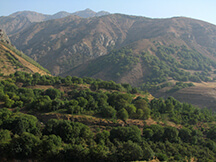No accident: Ancient walnut forests linked to languages, trade routes
September 3, 2015
 |
|
Persian walnut trees line the hills of Uzbekistan. (Photo submitted/Sergio Mapelli/Consiglio Nazionale delle Ricerche, Institute of Agricultural Biology and Biotechnology) |
WEST LAFAYETTE, Ind. - If Persian walnut trees could talk, they might tell of the numerous traders who moved along the Silk Roads' thousands of miles over thousands of years, carrying among their valuable merchandise the seeds that would turn into the mighty walnut forests that are spread across Asia.
Purdue University research shows that ancient languages match up with the genetic codes found in Persian walnut (Juglans regia) forests, suggesting that the stands of trees seen today may be remnants of the first planned afforestation known in the world.
In a paper published in the journal PLoS One, Keith Woeste, a research geneticist for the U.S. Department of Agriculture's Forest Service and a Purdue adjunct assistant professor of forestry, found that the evolution of language and spread of walnut forests overlapped over wide swaths of Asia over thousands of years. He believes as traders traversed the Silk Roads, connecting Eastern Europe and Africa with far-East Asia, they purposely planted walnut forests as a long-term agricultural investment.
"It was always assumed that there were wild forests of walnuts, like you'd find wild oak and maple forests here in the U.S.," said Woeste, who published the research with colleagues from the United Kingdom and Italy. "But what we had previously considered to be these wild walnut trees out in the middle of Asia were probably planted there."
Woeste said that while sampling walnut forests from 39 sites across Asia, his team noticed that the word for "walnut" was similar in many languages. That piqued their interest, so when genetic maps of the samples showed uncharacteristic relationships, they started looking at the link between genetics and languages.
If forests spread naturally, scientists would expect that genetic relatedness would spread in more concentric patterns. But Woeste said walnut genetics are related in long bands that spread east and west. For example, Woeste says walnuts in eastern Iran are closely related to walnuts in the Himalayas.
That suggests to him that traders were carrying walnuts along the Silk Roads. And those traders had likely been keeping walnuts from the best trees, selecting for genes that gave the trees desired characteristics for nuts and wood.
"Humans are always narrowing down genetic diversity to obtain a usable and more valuable crop," Woeste said.
Much like crops evolve, languages also change over time. For instance, Spanish, French and Italian are considered Romance languages, having evolved from Latin. As populations split from each other, their languages changed, making those new languages children of the original.
Having noticed the similarities in the word for "walnut" among several languages, Woeste and his colleagues grouped the languages currently spoken from the places where they sampled walnuts and traced the languages back to their ancestors. They found that the evolution of languages overlapped with the spread of walnut genetics.
Woeste believes this shows that as people moved along the Silk Roads and traded, they specifically selected walnuts and traded them along their routes. Instead of having just a few domestic trees, those who obtained walnuts likely put effort into creating walnut forests that could be used for food and wood.
"The factors that contribute to language being dispersed in Asia are the same as the way walnuts were dispersed," Woeste said. "It was the unique characteristics of walnut being useful for its wood and nuts that encouraged people to transport it, use it and then plant it as a forest as a long-term investment."
The European Community, under the framework of the Seventh Framework Programme under the Marie Curie Actions' Co-funding of Regional, National and International Programmes, called COFUND, supported the research.
The research is available at http://journals.plos.org/plosone/article?id=10.1371/journal.pone.0135980
Writer: Brian Wallheimer, 765-532-0233, brian.wallheimer@gmail.com
Source: Keith E. Woeste, 765-496-6808, woeste@purdue.edu
ABSTRACT
Ancient humans influenced the current spatial genetic structure of common walnut populations in Asia
Paola Pollegioni1, Keith E. Woeste2 ,Francesca Chiocchini1, Stefano del Lungo3, Irene Olimpieri1, Virginia Tortolano1, Jo Clark4, Gabriel E. Hemery5, Sergio Mapelli6, Maria Emilia Malvolti1
1 C.N.R. Institute of Agro-environmental and Forest Biology, Terni, Italy
2 U.S.D.A. Forest Service, Hardwood Tree Improvement and Regeneration Center, Department of Forestry and Natural Resources, Purdue University
3 C.N.R. The Institute of Archaeological and Monumental Heritage, Potenza, Italy.
4 Earth Trust, Little Wittenham, Abingdon, Oxfordshire, United Kingdom.
5. Sylva Foundation, Little Wittenham, Oxfordshire, United Kingdom.
6 C.N.R. Institute of Agricultural Biology and Biotechnology, Milan, Italy.
Common walnut (Juglans regia L) is an economically important species cultivated worldwide for its wood and nuts. It is generally accepted that J. regia survived and grew spontaneously in almost completely isolated stands in its Asian native range after the Last Glacial Maximum. Despite its natural geographic isolation, J. regia evolved over many centuries under the influence of human management and exploitation. We evaluated the hypothesis that the current distribution of natural genetic resources of common walnut in Asia is, at least in part, the product of ancient anthropogenic dispersal, human cultural interactions, and afforestation. Genetic analysis combined with ethno-linguistic and historical data indicated that ancient trade routes such as Persian Royal Road and Silk Road enabled long-distance dispersal of J. regia from Iran and Trans-Caucasus to Central Asia, and from Western to Eastern China. Ancient commerce also disrupted the local spatial genetic structure of autochthonous walnut populations between Tashkent and Samarkand (Central-Eastern Uzbekistan), where the northern and central routes of the Northern Silk Road converged. A significant association between ancient language phyla and genetic structure of walnut populations remained even after adjustment for geographic distances that could have affected both walnut gene flow and human commerce over the centuries.
Ag Communications: (765) 494-2722;
Keith Robinson, robins89@purdue.edu
Agriculture News Page

